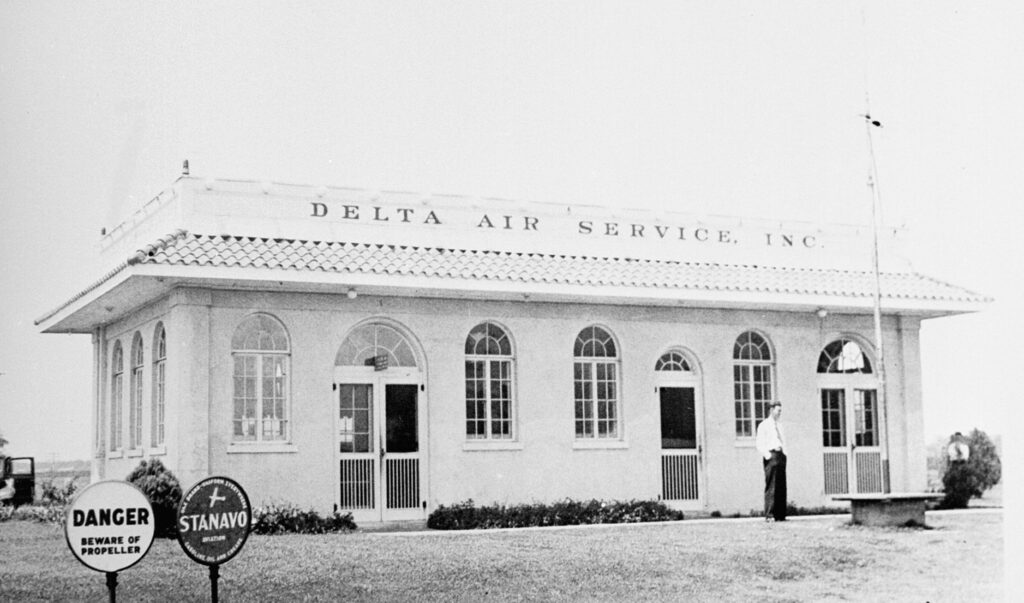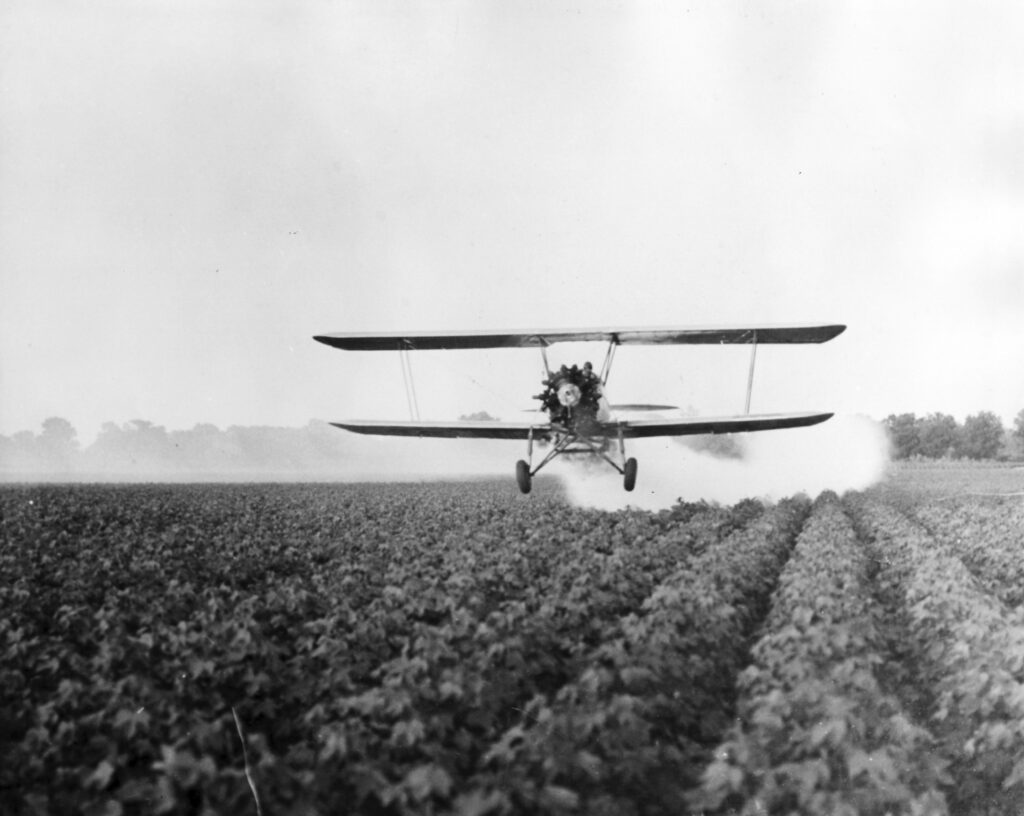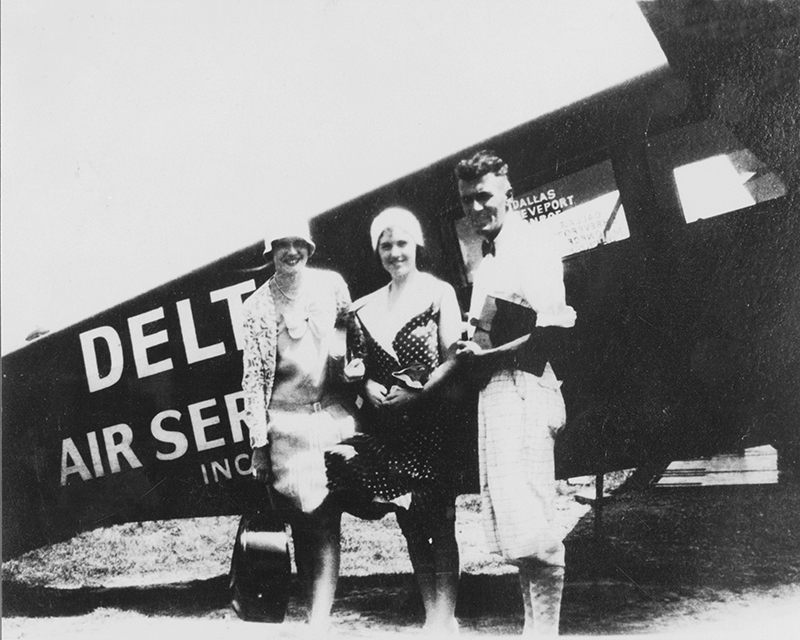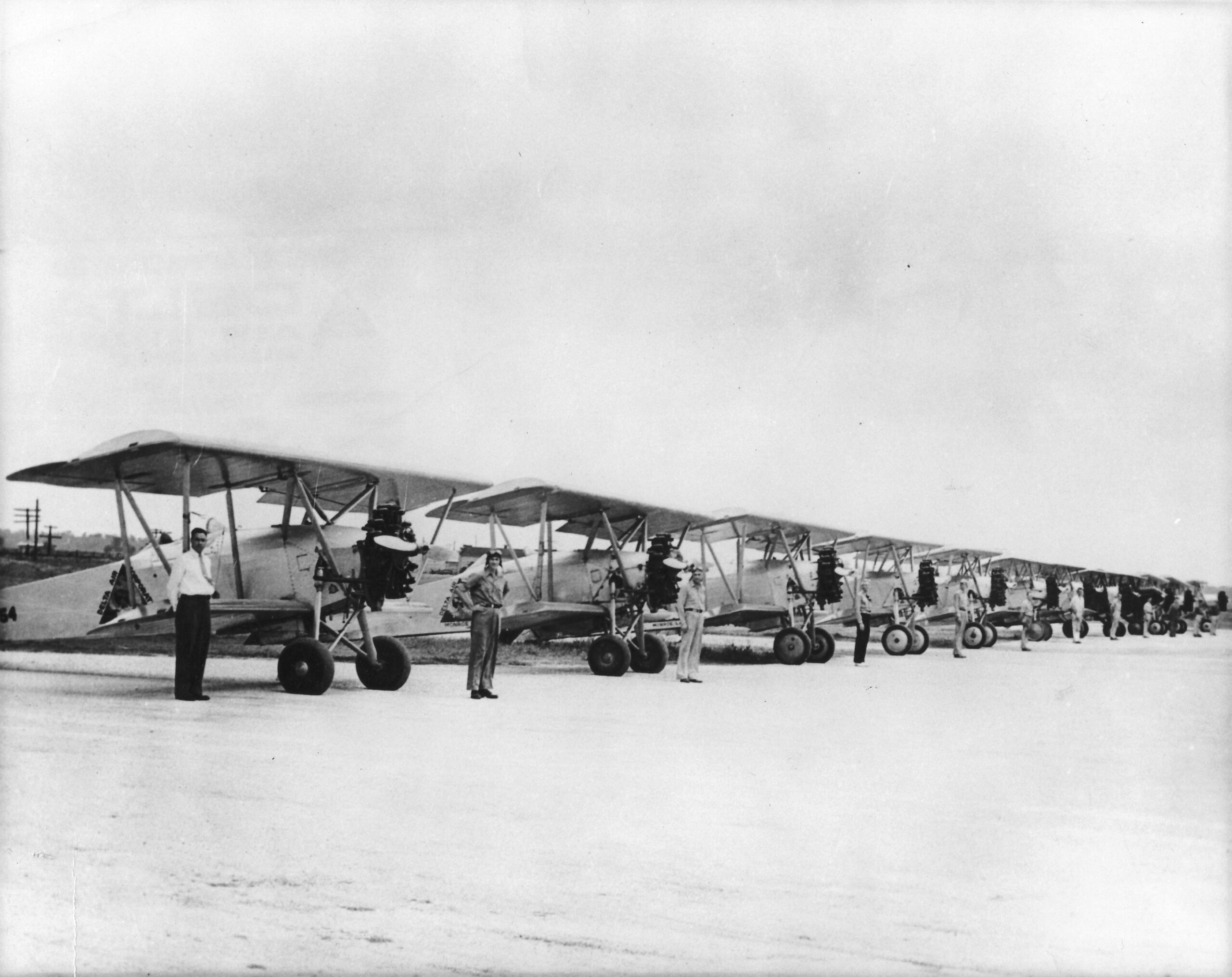Idea took root in a Delta cotton field
Gulf Coast Airlines? Doubtful.
Hill Country Airlines? Never heard of it.
Delta Airlines? Now that’s a different story.
But if the boll weevil hadn’t spread from Mexico in the 1890s to devastate Delta cotton, there might never have been a Delta Airlines either. The boll weevil was such a serious economic threat that the U.S. Bureau of Entomology set up a large-scale cotton insect research laboratory in Tallulah, Louisiana, in the early 1920s in a structure built by Standard Oil Company, known today as Scott’s Field and listed on the National Register of Historic Buildings.
The widespread use of calcium arsenate for weevil control had begun. Cotton farmers needed a method to apply the dry powder insecticide faster and more effectively than sprinkling by hand, mule-drawn wagon or tractor. Gasoline-powered engines were soon operating fans to distribute the poison, but application by air seemed more practical. Beginning in 1918, attempts were made at aerial crop dusting, with the first successful ones three years later.
Dr. B.R. Coad, director of the Tallulah Lab, learned of the success. The Louisiana researcher’s government program, financed by Delta and Pine Land Company of Scott, Mississippi, began pursuing the possibility of using airplanes to distribute the poison.
“Everybody laughed at the idea and scorned it at first,” Coad later wrote, “but our old friends at Scott still stood behind me. By 1922, we had been able to twist the Army Air Corps out of a short loan of a couple of their old Jenny trainer planes.”
“Perhaps his most significant achievement, especially for Delta planters, was way back on July 19 of 1924 within sight of the Delta and Pine Land headquarters,” wrote B.J. Skelton in a 1965 Delta Review article.
“Armyworms were moving into the cotton fields, doing a terrific amount of damage. The farm manager at D&PL was having calcium arsenate spread through the fields by means of a hickory pole attached to a mule’s back and holding a gunny sack full of poison on each end. The animals were driven down the rows at a trot to jolt the insecticide out of the sacks.
“Asked if they thought the poison could be dropped from the air, J.O. Dockery and Allen Scott answered in the affirmative, and they forthwith removed the front seat of the plane, moved the gas tanks and installed a hopper. Everything was soon ready except the question of who would fly the plane. An argument ensued, and Dockery won––by the flip of a coin, he recalled. Anyway, he shortly regretted his insistence for on his first pass at the field, he pulled the lever to release the calcium carbonate and it swooshed up in to his face, nearly choking him.
“However, the young pilots, after some quick work on the hopper, managed to get the bugs out of it, so to speak, and cotton dusting was born,” Skelton wrote.
Soon, partly to show the farmers what had been accomplished, but mainly for publicity to pry appropriations out of Washington, Coad arranged a demonstration on cotton fields at Scott. “Everything went off well and the whole thing was so new that nobody knew what to expect anyway,” he said.
Collett E. Woolman, a young district agent of the Extension Department of Louisiana State University, an aviation enthusiast and the future principal founder of Delta Air Lines, was a frequent and interested observer.
Woolman and several partners founded Huff Daland Dusters on May 30, 1924, in Macon, Georgia, as the world’s first aerial crop dusting company. A lack of experience and the small amount of cotton in the area resulted in an unsuccessful first season. Dr. Coad suggested the Dusters move to the Ark-La-Miss Delta. In 1925, the operation relocated to Monroe, Louisiana. Huff Daland’s 18 planes were the largest privately owned fleet in the world.
Soon, Huff Daland Dusters perfected the first real crop dusting plane and went into the commercial dusting business, serving Delta cotton growers for many years. From its start as a crop dusting company, the firm branched out to become one of the world’s largest airlines and Coad ultimately became head of its agricultural division.
In 1928, Woolman was looking for investors to buy Huff Daland Dusters. Once he was successful, the group renamed it Delta Air Service, honoring the Delta region it served. D.Y. Smith was its first president and Woolman became vice president and general manager. The original directors of Delta Air Service were C.H. McHenry, Travis Oliver and Malcolm S. Biedenharn. Beidenharn’s father, Joseph Biedenharn of Vicksburg, is credited with first bottling Coca-Cola in 1894. The family purchased the Coke plant in Monroe in 1912. Joe Biedenharn then bought the plant from the other family members and settled there the following summer with sons Malcolm and Bernard.
“It is my understanding that Bernard, the younger brother, was more involved in Delta than Malcolm. It was a family venture nonetheless,” once said cousin Mona Biedenharn of Brandon. “I know the records show Malcolm as an original director. Regardless, Bernard was the one who became the largest individual stockholder. It may be because Malcolm died in 1950, at which time Bernard may have stepped into his position,” she says.



“The family put up money for Delta three times, first to start the duster, then for the passenger operation, and then again when the mail contract in 1934 was secured,” Bernard said in a November 28, 1982, Washington Post article.
Bernard never sold any of his stock and was the largest individual investor in Delta Airlines. By the 1980s, the Biedenharn Delta Airline stock was worth more than $20.4 million. This led to several anomalies that puzzled outsiders.
Since Biedenharn lived in Monroe, Delta flights between Dallas and Jackson (the airline’s original route) always stopped in Monroe, whether there was a passenger ticketed for the city or not.
And for years, the annual meeting of Delta Airlines was held in the boardroom of Monroe’s Central Bank. Directors from across America would fly in and the occasional director, armed with the 50,000 or 100,000 shares he owned, would suggest that a company of Delta’s stature should move its annual meeting to a more fashionable location, perhaps New York or San Francisco.
Bernard was described by his cousin Mona as “quiet, humble conservative and the sweetest person you’d ever meet.” Nonetheless, his repeated response to suggestions that the meeting move out of the Monroe bank building was “I own 551,909 shares––and it’s gonna be right here.”
Monroe served as the home of Delta until 1941 when the company relocated to Atlanta to center itself along its new route network that now stretched to Chicago, Miami and New Orleans. Delta maintained mainline jet service to Monroe until 2002 despite the city’s small size. Monroe’s Regional Airport’s logo is a “Delta” symbol and bears the statement “Birthplace of Delta Air Lines” at the entrance and on its website. Monroe is also the site of the first Coca-Cola bottling plant, the source of Biedenharn’s wealth.
Delta crop dusting operations continued until 1966, but new undertakings began in 1928, with the purchase of three five-passenger, 90-mile-per-hour Travel Air monoplanes. On June 17, 1929, Delta Air Service operated its first passenger flight over a route that stretched from Dallas to Jackson with stops in Shreveport and Monroe. As additional planes were delivered from the factory, service was extended eastward to Birmingham and westward to Fort Worth.
Delta’s new activity represented a bold financial venture since the route was operated without benefit of a mail contract, and revenue from airmail was needed to supplement passenger operation expenses. Service began to Atlanta in 1930, but lack of a contract to carry mail forced suspension of passenger service. That year the company was renamed Delta Air Corporation.
In 1934, Delta had an opportunity to win back the route it had pioneered when the U.S. Post Office canceled all airmail contracts and called for new bids. Delta’s bid won the contract for Air Mail Route 24 route from Fort Worth to Charleston, South Carolina, via Atlanta. Delta’s first airmail flight on July 4, 1934, was flown in a Stinson T aircraft. This plane was capable of carrying seven passengers and the mail at speeds of 100 miles per hour. Delta restarted passenger service a month later with a route from Charleston to Fort Worth, with stops in Columbia, Augusta, Atlanta, Birmingham, and Meridian along the way. From this point Delta’s climb to prominence in air transportation was firmly established.
Airlines come and airlines go, but Delta has somehow been able to weather the storm. Following World War II, Delta acquired Chicago and Southern Air Lines, Northeast Airlines, Western Airlines and Northeast Airlines. In 1991, Delta purchased substantially all of Pan Am’s transatlantic routes plus the Pan Am Shuttle, the largest acquisition of flights in airline history. And lately, Delta began absorbing Northwest Airlines to become the world’s largest.
Not bad for a business that began dusting calcium arsenate on Delta cotton fields.


